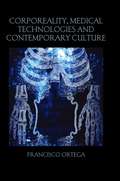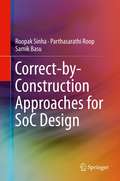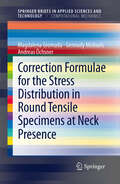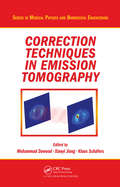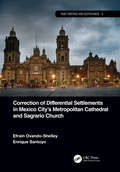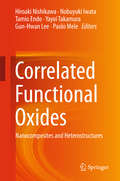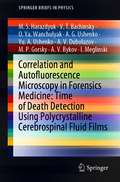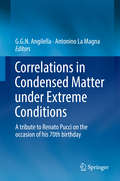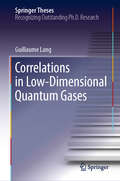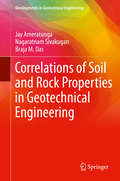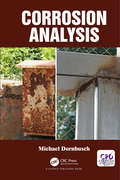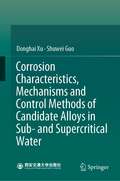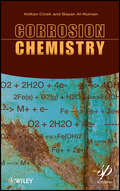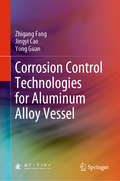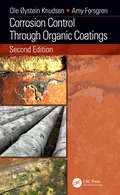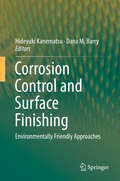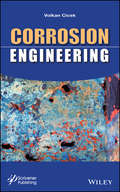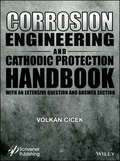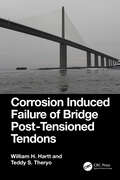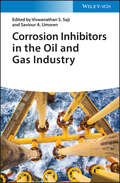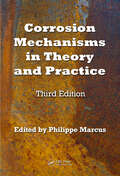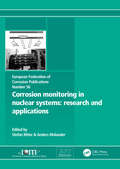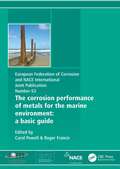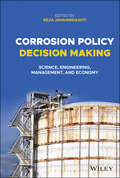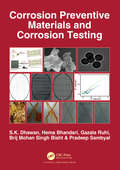- Table View
- List View
Corporeality, Medical Technologies and Contemporary Culture: Corporeality, Medical Technologies And Contemporary Culture (Birkbeck Law Press)
by Francisco OrtegaThis book examines the confusions and contradictions that manifest in prevalent attitudes towards the body, as well as in related bodily practices. The body is simultaneously our reference for the certainties of nature and the locus of a desire for transformation and reinvention. The body is at the same time worshipped and despised; an object of desire and of design. Francisco Ortega analyses how the body has become both a screen for the projection of our ideas and imaginings about ourselves and conversely an object of suspicion, anxiety, and discomfort. Addressing practices of corporeal ascesis (such as bodybuilding and dietetics), medical technologies, and radical anatomical modifications, Ortega documents the ambiguous legacy of a western theoretical tradition that has always despised the body. Utilising a theoretical framework that is mainly informed by the phenomenology of the body, feminist theory, disability studies and the thought of Michel Foucault, Corporeality, Medical Technologies and Contemporary Culture address several ethical and psychological issues associated with the experience and perception of the body in our cultural landscape. Drawing on these diverse areas of philosophical and analytical work, this book will interest those researching Law, Medicine, and Sociology.
Correct-by-Construction System on Chip Design
by Parthasarathi Roop Samik Basu Roopak SinhaThis book describes an approach for designing Systems-on-Chip such that the system meets precise mathematical requirements. The methodologies presented enable embedded systems designers to reuse intellectual property (IP) blocks from existing designs in an efficient, reliable manner, automatically generating correct SoCs from multiple, possibly mismatching, components.
Correction Formulae for the Stress Distribution in Round Tensile Specimens at Neck Presence (SpringerBriefs in Applied Sciences and Technology)
by Andreas Öchsner Magdalena Gromada Gennady MishurisThe monograph deals with methods to determine mechanical properties and evaluate the flow curve of ductile materials from the tensile test. It presents classical hypotheses concerning the onset of neck creation as well as the state of the art in determining the mechanical properties from the tensile test, with emphasis on the consequences of the neck formation. It revises derivations of formulae for the stress distribution in the minimal cross-section of the axisymmetrical specimen in the classical approaches proposed by Bridgman, Davidenkov / Spiridonova and Siebel as well as in the less famous formulae derived by Szczepinski and Malinin / Petrosjan. The revision is completed with solutions evaluated by the authors. In the monograph, the simplifying assumptions utilised in the classical approaches were carefully verified by numerical simulations accompanied by theoretical analysis. Errors imposed in the evaluation of the average axial stress acting on the minimal cross-section as a result of every particular simplification are estimated. The accuracy of all formulae to evaluate the flow curve is discussed. The significance of a high accurate determination can be seen in the context of numerical simulation (e.g. finite element computations), where the total error and accuracy is partly based on the accuracy of the material input.
Correction Techniques in Emission Tomography (Series in Medical Physics and Biomedical Engineering)
by Xiaoyi Jiang Mohammad Dawood Klaus SchäfersWritten by an interdisciplinary team of medical doctors, computer scientists, physicists, engineers, and mathematicians, Correction Techniques in Emission Tomography presents various correction methods used in emission tomography to generate and enhance images. It discusses the techniques from a computer science, mathematics, and physics viewpoint.
Correction of Differential Settlements in Mexico City's Metropolitan Cathedral and Sagrario Church (Built Heritage and Geotechnics)
by Efraín Ovando-Shelley Enrique SantoyoThis book describes the geotechnical aspects for correcting the geometry of Mexico City´s Metropolitan Cathedral and of the adjoining Sagrario Church. It describes the main aspects of geotechnical conditions in the city and of the most important hazards affecting these monuments. It discusses the analyses performed and the actions taken to achieve the corrections required. The book aims to provide non-specialists with a clear picture of the magnitude and importance of the project and of the achievements it fulfilled. It is expected that the book will also appeal to specialized geotechnical engineers that will be provided with references to follow up the project in depth. The book will contain a large number of illustrations and will be written so as to provide "down to earth" explanations of the basic theories applied and of the actual construction procedures The work will appeal to both students and professionals in the fields of Architecture and Civil Engineering. It will also interest specialized audiences of geotechnical engineers and conservation architects and it may also be of value to art historians.
Correlated Functional Oxides: Nanocomposites and Heterostructures
by Paolo Mele Tamio Endo Hiroaki Nishikawa Nobuyuki Iwata Yayoi Takamura Gun-Hwan LeeThis book introduces a variety of basic sciences and applications of the nanocomposites and heterostructures of functional oxides. The presence of a high density of interfaces and the differences in their natures are described by the authors. Both nanocomposites and heterostructures are detailed in depth by researchers from each of the research areas in order to compare their similarities and differences. A new interfacial material of heterostructure of strongly correlated electron systems is introduced.
Correlation and Autofluorescence Microscopy in Forensics Medicine: Time of Death Detection Using Polycrystalline Cerebrospinal Fluid Films (SpringerBriefs in Physics)
by A. G. Ushenko Yu. A. Ushenko I. Meglinski M.S. Harazdyuk V.T. Bachinsky O.Ya. Wanchulyak A.V. Dubolazov M.P. Gorsky A.V. BykovThis book highlights the first systematic synthesis of various research approaches in forensic medical diagnosis of the morphological and polycrystalline structure of human biological tissues and biological fluids. One of the global challenges in such diagnosis is the assessment of actual time of death. The relevance and objectivity of such studies are given by the innovative use of complex multifunctional methods using lasers and Mueller-matrix polarimetry, which is presented in this book. As a result, within the framework of the statistical, correlation and fractal approaches, diagnostic relationships were established between the time parameters of the transformation of the topographic structure of polarization-inhomogeneous microscopic images of biological preparations and necrotic changes in the morphological structure of biological tissues of the deceased. On this foundation, new forensic medicine criteria have been developed for objective determination of time of death.
Correlations in Condensed Matter under Extreme Conditions: A tribute to Renato Pucci on the occasion of his 70th birthday
by Antonino La Magna G. G. AngilellaThis book addresses a wide range of topics relating to the properties and behavior of condensed matter under extreme conditions such as intense magnetic and electric fields, high pressures, heat and cold, and mechanical stresses. It is divided into four sections devoted to condensed matter theory, molecular chemistry, theoretical physics, and the philosophy and history of science. The main themes include electronic correlations in material systems under extreme pressure and temperature conditions, surface physics, the transport properties of low-dimensional electronic systems, applications of the density functional theory in molecular systems, and graphene. The book is the outcome of a workshop held at the University of Catania, Italy, in honor of Professor Renato Pucci on the occasion of his 70th birthday. It includes selected invited contributions from collaborators and co-authors of Professor Pucci during his long and successful career, as well as from other distinguished guest authors.
Correlations in Low-Dimensional Quantum Gases (Springer Theses)
by Guillaume LangThe book addresses several aspects of thermodynamics and correlations in the strongly-interacting regime of one-dimensional bosons, a topic at the forefront of current theoretical and experimental studies. Strongly correlated systems of one-dimensional bosons have a long history of theoretical study. Their experimental realisation in ultracold atom experiments is the subject of current research, which took off in the early 2000s. Yet these experiments raise new theoretical questions, just begging to be answered. Correlation functions are readily available for experimental measurements. In this book, they are tackled by means of sophisticated theoretical methods developed in condensed matter physics and mathematical physics, such as bosonization, the Bethe Ansatz and conformal field theory. Readers are introduced to these techniques, which are subsequently used to investigate many-body static and dynamical correlation functions.
Correlations of Soil and Rock Properties in Geotechnical Engineering (Developments in Geotechnical Engineering)
by Braja M. Das Jay Ameratunga Nagaratnam SivakuganThis book presents a one-stop reference to the empirical correlations used extensively in geotechnical engineering. Empirical correlations play a key role in geotechnical engineering designs and analysis. Laboratory and in situ testing of soils can add significant cost to a civil engineering project. By using appropriate empirical correlations, it is possible to derive many design parameters, thus limiting our reliance on these soil tests. The authors have decades of experience in geotechnical engineering, as professional engineers or researchers. The objective of this book is to present a critical evaluation of a wide range of empirical correlations reported in the literature, along with typical values of soil parameters, in the light of their experience and knowledge. This book will be a one-stop-shop for the practising professionals, geotechnical researchers and academics looking for specific correlations for estimating certain geotechnical parameters. The empirical correlations in the forms of equations and charts and typical values are collated from extensive literature review, and from the authors' database.
Corrosion Analysis
by Michael DornbuschThe book gives an overview about all relevant electrochemical and spectroscopic methods used in corrosion research. Besides the correct use and interpretation, the methods are correlated with industrial test methods for organic coatings and conversion layers.
Corrosion Characteristics, Mechanisms and Control Methods of Candidate Alloys in Sub- and Supercritical Water
by Donghai Xu Shuwei GuoThis book aims to provide comprehensive and systematic introduction and summary of corrosion characteristics, mechanisms, and control methods of candidate alloys in sub- and supercritical water environment. First of all, corrosion types of candidate alloys and the effects of major alloying elements on corrosion resistance of potential alloys in sub- and supercritical water are compared and analyzed. At the same time, research status of candidate materials, and development and application trends of several corrosion-resistant alloys are summarized. Then, corrosion characteristics of Ni-Cr, Ni-Cr-Mo, Ni-Fe-Cr and Ni-Fe-Cr-Mo-Cu corrosion-resistant alloys, FeCrAl alloy, and Zircaloy are discussed in detail, including the corrosion rate, the structure and composition of oxide film, and the effects of various surface treatment processes, etc. More specifically, it also investigates corrosion behavior of Ni-based alloy, Fe-Ni-based, and stainless steels in supercritical water. The effects of aggressive species on the corrosion behavior of Ni-base alloys are also explored in supercritical water. Readers will further discover the total corrosion processes and mechanisms of typical candidate alloys in sub- and supercritical water environment. Finally, the work explores the corrosion control methods such as ceramic coatings and passivation processes in supercritical water oxidation and in subcritical water, respectively. Future challenges and development trends of corrosion research of candidate materials in sub- and supercritical water environments are covered at the end of this book. It offers valuable reference for theoretically guiding material selection and design and operating parameter optimization of key equipment in the sub- and supercritical water technologies. The book is written for senior undergraduates, graduate students, scholars, and researchers who are interested in corrosion behavior of candidate materials of supercritical water oxidation system, supercritical water gasification system, and nuclear reactor.
Corrosion Chemistry
by Volkan Cicek Bayan Al-NumanCorrosion Chemistry details the scientific background of the corrosion process and contemporary applications for dealing with corrosion for engineers and scientists, covering the most recent breakthroughs and trends. Corrosion is in essence a chemical process, and it is crucial to understand the dynamics from a chemical perspective before proceeding with analyses, designs and solutions from an engineering aspect. This book can be used both as a textbook and a reference book both by academics and engineers and scientists in the field. As a reference for the engineer in the field, it is both a refresher for the veteran on the causes of corrosion and the methods, processes, and technologies to deal with it, over a variety of industries. It is the most up-to-date, comprehensive treatment of corrosion available, covering the most cutting-edge new processes and theories. For the freshman engineer just entering the field, it is a tremendous introduction to corrosion. As a textbook, it can be used for a single semester technical elective course in undergraduate and postgraduate education for disciplines such as chemistry, chemical engineering, petroleum engineering, civil engineering, material engineering, mechanical engineering, metallurgical engineering, mining engineering, agricultural engineering, and other related technical fields.
Corrosion Control Technologies for Aluminum Alloy Vessel
by Yong Guan Zhigang Fang Jingyi CaoThis book elaborates the corrosion testing and assessment methods for the aluminum alloy vessel in the service and internal environment. The emphasis is placed on the research of general materials corrosion characteristics, electrochemical protection design, surface protection, coating and painting, etc. This book helps readers to keep abreast of the whole technology system of the corrosion prevention and control of aluminum alloy vessel, especially the systematic engineering view of life cycle corrosion control for the vessel is of particular interest to readers.
Corrosion Control Through Organic Coatings (Corrosion Technology)
by Amy Forsgren Ole Øystein KnudsenCorrosion Control Through Organic Coatings, Second Edition provides readers with useful knowledge of the practical aspects of corrosion protection with organic coatings and links this to ongoing research and development. Thoroughly updated and reorganized to reflect the latest advances, this new edition expands its coverage with new chapters on coating degradation, protective properties, coatings for submerged service, powder coatings, and chemical pretreatment. Maintaining its authoritative treatment of the subject, the book reviews such topics as corrosion-protective pigments, waterborne coatings, weathering, aging, and degradation of paint, and environmental impact of commonly used techniques including dry- and wet-abrasive blasting and hydrojetting. It also discusses theory and practice of accelerated testing of coatings to assist readers in developing more accurate tests and determine corrosion protection performance.
Corrosion Control and Surface Finishing: Environmentally Friendly Approaches
by Hideyuki Kanematsu Dana M. BarryThis book deals with the surface finishing for corrosion prevention fromthe viewpoint of environmental friendliness. Surface finishing for metallic materialsor by metallic materials has excellent corrosion resistance, wear resistance andgood color tones, which have been useful for practical applications so far. However,environmental friendliness and user friendliness have become important factors forpractical use since the turn of the century. Surface Finishing Industries are nowfacing a serious crossroad to continue sustainable developments in the future. Sadly,the concept of environmental friendliness is very new, because from the beginningof this discipline (surface finishing), not many people considered the environmentaleffects so seriously, but sought mainly for the functions, performance, characteristics,and economic profits. Since the biological evaluation processes are very advancedand still debated, this book is very unique and advanced. This book aims to letuniversity students know and learn the concept of environmental friendliness andits relation to surface treatment products based on the fundamental knowledge aboutconventional corrosion control and surface finishing. The textbook will be usedmost effectively with subjects such as surface science, surface engineering, mechanicalmaterials, etc. for those studying mechanical engineering, materials engineeringand chemical engineering. It is also applicable to practical engineers and researchersin the industrial world as well as the academic one. Throughout this book, readerslearn and appreciate the environmentally friendly approaches that are presentedfor corrosion control and surface finishing.
Corrosion Engineering
by Volkan CicekCorrosion costs billions of dollars to each and every single economy in the world. Corrosion is a chemical process, and it is crucial to understand the dynamics from a chemical perspective before proceeding with analyses, designs and solutions from an engineering aspect. The opposite is also true in the sense that scientists should take into consideration the contemporary aspects of the issue as it relates to the daily life before proceeding with specifically designed theoretical solutions. Corrosion Engineering is advised to both theoreticians and practitioners of corrosion alike.Corrosion engineering is a joint discipline associated primarily with major engineering sciences such as chemical engineering, civil engineering, petroleum engineering, mechanical engineering, metallurgical engineering, mining engineering among others and major fundamental sciences such as sub-disciplines of physical, inorganic and analytical chemistry as well as physics and biology, such as electrochemistry, surface chemistry, surface physics, solution chemistry, solid state chemistry and solid state physics, microbiology, and others.Corrosion Engineering is a must-have reference book for the engineer in the field that covers the corrosion process with its contemporary aspects with respect to both of its scientific and engineering aspects. It is also a valuable textbook that could be used in an engineering or scientific course on corrosion at the university level.
Corrosion Engineering and Cathodic Protection Handbook: With an Extensive Question and Answer Section
by Volkan CicekThe Corrosion Engineering and Cathodic Protection Handbook combines the author’s previous three works, Corrosion Chemistry, Cathodic Protection, and Corrosion Engineering to offer, in one place, the most comprehensive and thorough work available to the engineer or student. The author has also added a tremendous and exhaustive list of questions and answers based on the text, which can be used in university courses or industry courses, something that has never been offered before in this format. The Corrosion Engineering and Cathodic Protection Handbook is a must-have reference book for the engineer in the field, covering the process of corrosion from a scientific and engineering aspect, along with the prevention of corrosion in industrial applications. It is also a valuable textbook, with the addition of the questions and answers section creating a unique book that is nothing short of groundbreaking. Useful in solving day-to-day problems for the engineer, and serving as a valuable learning tool for the student, this is sure to be an instant contemporary classic and belongs in any engineer’s library.
Corrosion Induced Failure of Bridge Post-Tensioned Tendons
by William H. Hartt Teddy S. TheryoThis book provides an overview of post-tensioning (PT) in reinforced concrete bridge structures. It specifically addresses corrosion issues that were initially unforeseen but subsequently occurred, raised concerns regarding structural integrity and long-term viability. It begins by exploring the introduction and background of PT bridge development, addressing post-tensioning systems and the various types of PT bridge construction methods. It also covers corrosion issues and failures that have previously occurred, and other designs for durability. Further, it goes into the details of experimental investigations of corrosion-caused bridge PT tendon failures, and the modeling efforts of wire and strand fractures. Lastly, it provides an assessment of the path forward, suggesting alternatives for current inspection and condition assessment.This book is highly recommended for graduate and postgraduate students of civil, structural, and mechanical engineering. It will also be an interesting read for structural and civil engineers, and researchers involved with integrity assurance of PT structures.
Corrosion Inhibitors in the Oil and Gas Industry
by Viswanathan S. Saji Saviour A. UmorenProvides comprehensive coverage of corrosion inhibitors in the oil and gas industries Considering the high importance of corrosion inhibitor development for the oil and gas sectors, this book provides a thorough overview of the most recent advancements in this field. It systematically addresses corrosion inhibitors for various applications in the oil and gas value chain, as well as the fundamentals of corrosion inhibition and interference of inhibitors with co-additives. Corrosion Inhibitors in the Oil and Gas Industries is presented in three parts. The first part on Fundamentals and Approaches focuses on principles and processes in the oil and gas industry, the types of corrosion encountered and their control methods, environmental factors affecting inhibition, material selection strategies, and economic aspects of corrosion. The second part on Choice of Inhibitors examines corrosion inhibitors for acidizing processes, inhibitors for sweet and sour corrosion, inhibitors in refinery operations, high-temperature corrosion inhibitors, inhibitors for challenging corrosive environments, inhibitors for microbiologically influenced corrosion, polymeric inhibitors, vapor phase inhibitors, and smart controlled release inhibitor systems. The last part on Interaction with Co-additives looks at industrial co-additives and their interference with corrosion inhibitors such as antiscalants, hydrate inhibitors, and sulfide scavengers. -Presents a well-structured and systematic overview of the fundamentals and factors affecting corrosion -Acts as a handy reference tool for scientists and engineers working with corrosion inhibitors for the oil and gas industries -Collectively presents all the information available on the development and application of corrosion inhibitors for the oil and gas industries -Offers a unique and specific focus on the oil and gas industries Corrosion Inhibitors in the Oil and Gas Industries is an excellent resource for scientists in industry as well as in academia working in the field of corrosion protection for the oil and gas sectors, and will appeal to materials scientists, electrochemists, chemists, and chemical engineers.
Corrosion Mechanisms in Theory and Practice (Corrosion Technology)
by Philippe MarcusUpdated to include recent results from intensive worldwide research efforts in materials science, surface science, and corrosion science, Corrosion Mechanisms in Theory and Practice, Third Edition explores the latest advances in corrosion and protection mechanisms. It presents a detailed account of the chemical and electrochemical surface reactions
Corrosion Monitoring in Nuclear Systems EFC 56: Research and Applications (European Federation of Corrosion Publications)
by Stefan RitterCorrosion remains one of the key issues affecting the performance and availability of nuclear power plants. Therefore, reliable in-plant corrosion monitoring methods are essential both for the future operation of existing plants and to ensure the safety of future nuclear waste disposal systems.In two parts, this book was stimulated by a workshop organised by EFC Working Party 4 on Nuclear Corrosion and the European Cooperative Group on Corrosion Monitoring of Nuclear Materials (EGC-COMON). The first part deals mainly with research into the detection of stress corrosion crack initiation in nuclear power plant environments (essentially high temperature water at around 300 °C) by various methods, particularly the electrochemical noise technique but also including the electrochemical impedance, acoustic emission and direct current potential drop methods. The second part addresses the goal to develop in-situ techniques and includes examples of the application of electrochemical corrosion potential monitoring.This book will be of particular interest to scientists and engineers concerned with the mitigation of corrosion in nuclear systems.
Corrosion Performance of Metals for the Marine Environment EFC 63: A Basic Guide (European Federation of Corrosion Publications)
by Roger FrancisEngineers with an interest in the marine environment can take advantage of many years of accumulated corrosion experience in a quick and concise manner with this publication. It covers the corrosion behavior in sea water of steel, stainless steel and cast iron as well as alloys of copper, aluminum, nickel and titanium. Applications, commonly-used alloy compositions and mechanical properties are also covered for each alloy system, plus a special section is devoted to galvanic corrosion and its avoidance.
Corrosion Policy Decision Making: Science, Engineering, Management, and Economy
by Reza JavaherdashtiCORROSION POLICY DECISION MAKING Explore the science, management, economy, ecology, and engineering of corrosion management and prevention In Corrosion Policy Decision Making, distinguished consultant and corrosion expert Dr. Reza Javaherdashti delivers an insightful overview of the fundamental principles of corrosion with a strong focus on the applicability of corrosion theory to industrial practice. The authors demonstrate various aspects of smart corrosion management and persuasively make the case that there is a real difference between corrosion management and corrosion knowledge management. The book contains seven chapters that each focuses on one important aspect of corrosion and corrosion management. Corrosion management is an issue that is not just corrosion science or corrosion engineering but rather a combination of both elements. To cover this paradoxical aspect of corrosion management, chapter 2 deals with some basic, introductory concepts and principles of corrosion and coating/painting (an important corrosion protection method) while chapter 3 explains the elements of smart corrosion management in detail. Another important principle of smart corrosion management is to be able to study the cost of corrosion, chapter 4 introduces important points in the economics involved in a smart corrosion management. As indicated earlier, corrosion engineering is also an integral part of corrosion management and thus chapter 5 looks at the engineering side of corrosion by detailing the example of Process Additives (EMPA). Chapter 6 for the first time looks at the possibility of using TRIZ (algorithm of invention) in corrosion management. Finally, chapter 7 presents the necessary elements for building a model that would explore the mutual interaction between corrosion and environment mainly by exploring the difference between environmental impact and environmental effect. Chapter 7 is also very important because the four models so far applied to estimate the cost of corrosion (Uhlig Method, Hoar Method, I/O method and LCC method) are not capable of suggesting any clear model or a sensible way of exploring the elements necessary to explain the impact of indirect costs of corrosion the most important of which being environmental damages imposed by corrosion. This book is ideal for engineers, students, and managers working or studying corrosion, Corrosion Policy Decision Making is also an indispensable resource for professionals in the fields of upstream and downstream, on-shore/off-shore oil and gas, transportation, mining, power generation as well as major sectors of other strategic industries.
Corrosion Preventive Materials and Corrosion Testing
by S.K. Dhawan Hema Bhandari Gazala Ruhi Brij Mohan Bisht Pradeep SambyalThe book provides an extensive coverage of conjugated polymer based nano-composite coatings with advanced anti-corrosive properties. The book gives detailed explanation of corrosion testing methods and techniques to evaluate the corrosion resistance of the coatings. It includes elaborate discussion on classification of corrosion, electrochemistry of corrosion process, theories explaining the mechanism of corrosion and various corrosion testing standards. Electrochemical studies like open circuit potential (OCP) variation with time, potentiodynamic polarization, Electrochemical Impedance Spectroscopy (EIS) and accelerated corrosion testing are highlighted as important tools to extract information about the behavior of coatings under corrosive conditions. The book discusses epoxy-conjugated polymer based novel composite coating formulations, including aniline and o-toluidine, o-anisidine, phenetidine and pentafluoroaniline with appropriate fillers like SiO2, flyash, ZrO2 nanoparticles, and chitosan for the protection of metallic substrates. A general discussion on the self healing mechanism of epoxy-polypyrrole based biopolymer hybrid composite coatings is included in this book. This book provides a critical review on the conjugated polymer based composite coatings with superior corrosion resistance, good mechanical integrity, better adhesion properties and self healing ability under highly aggressive conditions which can be commercially used for the protection of metal substrates from corrosion.
